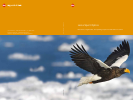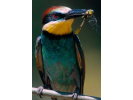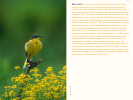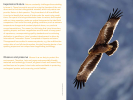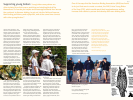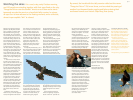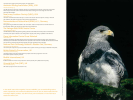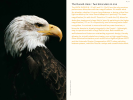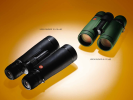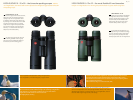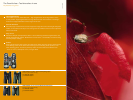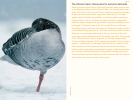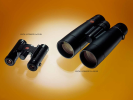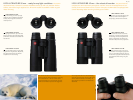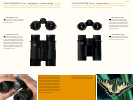
Watching the skies It’s a cool, crisp, early October morning
and 100 people are standing together with their eyes fixed on the sky.
“Peregrine Falcon over the bunker” shouts one of them as he simul-
taneously records the event on a hand-held tally counter. In unison,
all eyes turn to bear witness to the fleeting moment, and a collective,
almost imperceptible “ahh” is uttered.
By sunset, the herald with the tally counter called out the name
“Peregrine Falcon” 256 more times, and recorded the passing of
another four thousand hawks, eagles and falcons during their
southward transit over historic Cape May, New Jersey.
Standing on the spacious hawk watch
platform in Cape May Point State Park
today, it’s difficult to imagine the Cape
May Hawk Watch of thirty years ago.
Most noticeable, the crowds of birders
were considerably smaller. Dozens during
the week (perhaps) and scores on the
weekends are nothing compared to the
tens of thousands of people who now
travel to Cape May each fall. In 1976, a
rickety table that accommodated one
person, is now a two-tiered, state-of-the-
art observation deck seats more than
200 visitors. Back then, a single person
did everything – bird counting, back yard
ornithology, and Cape May Bird Obser-
vatory ambassador. Now, two official
counters and two interpretive naturalists
handle the flow of migrating hawks and
questions from throngs of visiting hawk
watchers.
In 1976, however, the importance of
the data we were collecting to future
raptor conservation efforts was clear, and
this understanding has not changed thirty
years later. For several decades before
the start of the Cape May Hawk Watch,
raptor populations were ravaged by the
effects of DDT, a chemical used to con-
trol agricultural pests. Species like
Peregrine Falcon and Bald Eagle declined
precipitously. This debacle became the
environmental community’s rallying cry
for greater controls on pesticide use.
Thirty years of data have helped to docu-
ment the recovery of Peregrine Falcon,
Bald Eagle and other raptor species after
the use of DDT was banned. The data
also revealed more recent declines in
other species like Sharp-shinned Hawk
and American Kestrel, a diminutive
falcon.
Established in 1897, New Jersey
Audubon Society is a member supported
not-for-profit organization that has been
at the forefront of environmental educa-
tion, conservation and research for over
100 years. Initially, the Society was
formed to combat wholesale market
hunting of birds and to fight against the
decimation of birds to supply feathers to
the millinery industry. Our efforts, and
those of other Audubon societies, were
instrumental in the passage of the
Migratory Bird Treaty Act in 1911, a
regulation that still protects nearly all
bird species occurring in the United
States today.
The Cape May Bird Observatory, one of
New Jersey Audubon Society’s ten staffed
centers, made its debut the same year
that the Cape May Hawk Watch began.
Thirty years later it is a world renowned
bird watching center and a regional lea-
der in science-based bird conservation.
The Observatory entertains thousands
of visitors that come to Cape May to
experience the migration phenomena.
The scope of the Observatory’s recent
scientific work includes the study of
shorebirds during spring migration
through Delaware Bay, which is a
hemispherically important staging area
for several species en route to the Arctic,
breeding grassland birds, evaluating the
impact of wind power development, and
assessing population trends in migrating
raptors and waterbirds.
But what makes Cape May so special
when it comes to birds, especially those
species that make annual migratory
journeys. The business world mantra
“location, location, location,” applies
here. While migration occurs all over the
Northern (and much of the southern)
Hemisphere, it is not evenly apportioned.
If you look at southern New Jersey,
trapped between Delaware Bay to the
west and the Atlantic Ocean to the east,
the geography resembles a big funnel
with Cape May Peninsula at the terminus.
Prevailing northwesterly winds in fall push
southbound migrants into the funnel’s
mouth.
Tens of thousands of hawks and
millions of songbirds get “trapped” at
the end of the funnel – squeezed onto
the peninsula where they back up before
deciding to cross Delaware Bay. This
often results in spectacular hawk flights
and fallouts of migrants – much to the
pleasure of birdwatchers.
Biologists also find these major con-
centrations useful because they put large
portions of species’ population in the
same place at nearly the same time,
which is an efficient way to assess their
status. This is especially important for
many raptor species, which are difficult
to monitor during the breeding season.
Data collected during the Cape May
Hawk Watch’s 30 year tenure has been
instrumental in understanding the
population dynamics of several species.
Like most things in life, environmental
education, conservation, and research
can be an expensive business. The suc-
cess of New Jersey Audubon Society and
Cape May Bird Observatory is dependent
in large part on the financial support of
its members and cooperative agreements
with government agencies. Another
important means of support are partner-
ships with corporate entities that have
clear natural resource conservation
awareness and a connection with the
bird watching and conservation
community. Leica Sports Optics is
one of these entities.
The history of birding is intrinsically
linked with the history of optics. As optics
improved, so too did birding’s skill level,
and popularity. Leica has been at the
forefront of this birding revolution. The
Trinovid binocular has been a stalwart of
the birding community since its introduc-
tion. Leica continues to be a leader in
optical equipment innovation, especially
for bird watching applications. This is
most evident in its state-of-the-art Televid
APO spotting scope and the recent deve-
lopment of the Ultravid binocular. This
binocular features exceptional field of
view, superior depth of field, and close,
fast focus, making it the ideal instrument
for flight identification of raptors and
other bird species. This is why we feel
strongly that Leica Sport Optics is the
ideal partner for the Cape May Hawk
Watch joint venture. If you visit Cape May
between September 1 and November 30,
you can see the fruits of this cooperative
agreement – and more than a few birds.
David Mizrahi, Ph.D.
Vice-president for Research
New Jersey Audubon Society
Leica Supports Research in Cape May
Leica is the official sponsor of the Cape
May Hawk Watch, and has supported
other co-operative research efforts as
well. In addition to providing funds for the
Hawk Watch staff, Leica supplied world
class optics for the project.
Leica binoculars and scopes are un-
rivaled for clarity and light gathering
ability, making the job of spotting and
identifying birds at a distance a breeze.
This fact is not lost on the thousands of
visitors that come to the Hawk Watch who
are encouraged to use the exceptional
optical equipment.
www.njaudubon.org/sites/HUCMBO.html
8 / 9



